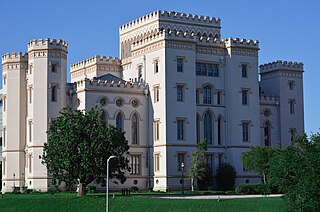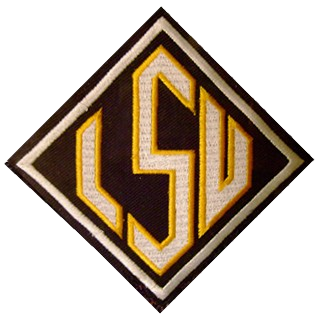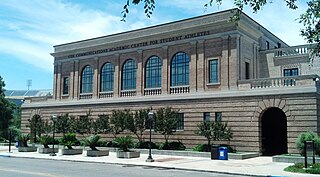
Baton Rouge is the capital city of the U.S. state of Louisiana. Located on the eastern bank of the Mississippi River, it had a population of 227,470 as of 2020; it is the seat of Louisiana's most populous parish (county-equivalent), East Baton Rouge Parish, and the center of Louisiana's second-largest metropolitan area, Greater Baton Rouge.

Louisiana State University is an American public land-grant research university in Baton Rouge, Louisiana. The university was founded in 1860 near Pineville, Louisiana, under the name Louisiana State Seminary of Learning & Military Academy. The current LSU main campus was dedicated in 1926, consists of more than 250 buildings constructed in the style of Italian Renaissance architect Andrea Palladio, and the main campus historic district occupies a 650-acre (260 ha) plateau on the banks of the Mississippi River.

Baton Rouge Magnet High School is a public magnet school in Baton Rouge, Louisiana, United States, founded in 1880. It is part of the East Baton Rouge Parish School System with a student body of approximately 1500 students. The current building was built in 1926, and, as Baton Rouge High School, was listed on the National Register of Historic Places in 1986. The campus underwent a two-year renovation and expansion starting in 2010, resulting in the addition of two new wings to the main building. This renovation was completed and the school reopened in fall 2012. Baton Rouge High is also one of the highest-ranked schools in the state, and consistently wins state-level academic competitions. The school requires students to pass enrollment standards and exceed graduation standards. As a result, nearly all graduating students attend college.

Tiger Stadium is an outdoor stadium located in Baton Rouge, Louisiana, on the campus of Louisiana State University. It is the home stadium of the LSU Tigers football team. Prior to 1924, LSU played its home games at State Field, which was located on the old LSU campus in Downtown Baton Rouge.

The Paul M. Hebert Law Center, often styled "LSU Law", is a public law school in Baton Rouge, Louisiana. It is part of the Louisiana State University System and located on the main campus of Louisiana State University.
The Reveille, formerly the Daily Reveille, has been since 1887 the student newspaper at Louisiana State University in Baton Rouge, Louisiana. It prints twice a week on Mondays and Thursdays during the fall and spring semesters, and once a week on Monday in the summer. It publishes online content daily at LSUReveille.com. The Reveille has a weekly circulation of about 6,000 copies.

The LSU Tigers and Lady Tigers are the athletic teams representing Louisiana State University (LSU), a state university located in Baton Rouge, Louisiana. LSU competes in Division I of the National Collegiate Athletic Association (NCAA) as a member of the Southeastern Conference (SEC).

Mignon Faget is a jewelry designer based in her native New Orleans, Louisiana. Faget has long been acknowledged as one of New Orleans' premier designers of fine jewelry.

The Louisiana State University Tiger Marching Band is the marching band of Louisiana State University (LSU). The band has 325 members and performs at all LSU football home games, all bowl games, and away games.

Istrouma High School is an accredited public school located in Baton Rouge, Louisiana, United States. It was founded in 1917, and is located in East Baton Rouge Parish. Its name is a local Indian word meaning "red stick". Red stick is also the English language translation of the French words baton rouge. The area of north Baton Rouge where the school is located is also known as the Istrouma area.

The Magnolia Bowl is name given to the LSU–Ole Miss football rivalry. It is an American college football rivalry game played annually by the LSU Tigers football team of Louisiana State University (LSU) and the Ole Miss Rebels football team of the University of Mississippi. The teams compete for the Magnolia Bowl Trophy. The Tigers and the Rebels first met in 1894, and have been regular opponents in Southeastern Conference (SEC), meeting annually, without interruption, since 1945.

Broadmoor Senior High School is an accredited high school in Baton Rouge, Louisiana, United States. It is a part of the East Baton Rouge Parish School System.
Baker High School is an accredited public high school in Baker, Louisiana. It is a part of the City of Baker School System.

Louisiana State University'sBusiness Education Complex is a campus extension of Louisiana State University and A & M College located in Baton Rouge, Louisiana. It is designated to house part of E. J. Ourso College of Business.

Huey P. Long Field House, on the campus of Louisiana State University in Baton Rouge, Louisiana, was constructed in 1932. It was named for notable U.S. Senator and state governor Huey Long. The field house is considered the original student union and included a post office, ballroom, gymnasium and also featured the largest swimming pool in the United States at the time.

The LSU Cox Communications Academic Center for Student-Athletes, on the campus of Louisiana State University in Baton Rouge, Louisiana, is located in the Gym/Armory building. The building opened in 1930 and was completely renovated and reopened in 2002 to house the Academic Center for Student-Athletes.
Raymond D. Strother was a nationally known Democratic political consultant, originally from Port Arthur, Texas.
The "LSU Alma Mater" was written in 1929 by Lloyd Funchess and Harris Downey, two students who developed the original song and music because LSU's first alma mater was sung to the tune of "Far Above Cayuga's Waters" and was used by Cornell University. The band plays the "Alma Mater" during pregame and at the end of each home football game. Also, members of the band join arm-in-arm at the end of rehearsals on Saturday game days and sing the "Alma Mater" before leaving the practice facility.

Jonathan H. Earle is an author, historian, professor, and dean. He is an historian of American politics and culture who focuses on the early republic and antebellum periods, especially the antislavery movement and the sectional crisis leading up to the Civil War. Currently Earle serves as Dean of the Roger Hadfield Ogden Honors College at Louisiana State University, a post he has held since 2014.




















